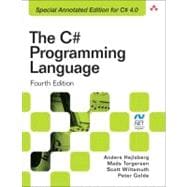The definitive reference to the C# Programming Language, updated for the new version 4.0, direct from its creator, Anders Hejlsberg
New to this edition - all code presented in full color.
Contains insightful, valuable annotations from twelve leading C# programmers, available nowhere else.
C# has become the most widely used language for Windows development.
Anders Hejlsberg is the creator of C#, and a true legend among programmers. C# is now firmly established as the most-used language when writing applications for Windows and the Microsoft platform.
Written by the language's architect, Anders Hejlsberg, and design team members, and now updated for C# 4.0, The C# Programming Language, 4/e, is the definitive technical reference for C#. It provides the most complete specification of the languages, along with descriptions, reference materials, and code samples from the C# design team.
This edition also adds valuable notes, comments, and tips from twelve of the world's top C# programmers, including Bill Wagner, Chris Sells, Jesse Liberty, and Brad Abrams. It has been brought fully up to date with the new features of C# 4.0. And new to this edition, all the code will be presented in full color, so that it appears in the book exactly as it appears on screen. This book is a must-have for any developer using C# on a regular basis.
“Based on my own experience, I can safely say that every .NET developer who reads this will have at least one ‘aha’ moment and will be a better developer for it.”-From the Foreword by Don Box








